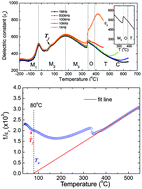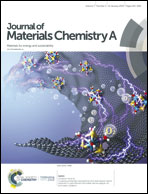Phase transitions in tantalum-modified silver niobate ceramics for high power energy storage
Abstract
Ag(Nb0.8Ta0.2)O3 is used here as a model system to shed light on the nature of the low temperature phase behavior of the unsubstituted parent compound AgNbO3, which is an important material for high-power energy storage applications. The three dielectric anomalies previously identified as M1 ↔ M2, Tf and M2 ↔ M3 transitions in AgNbO3 ceramics are found to be intimately related to the polarization the behavior of the B-site cations. In particular, the M1 ↔ M2 transition is found to involve the disappearance of original ferroelectric polar structure in the M1 phase. Analysis of weak-field and strong field hysteresis loops in the M2 region below Tf suggests the presence of a weakly-polar structure exhibiting antipolar behavior (i.e., a non-compensated antiferroelectric), which can be considered as ferrielectric (FIE). Modeling of the permittivity data using the Curie–Weiss law indicates that the Curie temperature is close to the freezing temperature, Tf, which can be regarded as the Curie point of the FIE phase. Substitution by Ta5+ in this system enhances the stability of the weakly polar/antiferroelectric state, giving rise to an increased energy storage density of 3.7 J cm−3 under an applied field of 27 MV m−1, one of the highest values ever reported for a dielectric ceramic. Furthermore, the energy storage capability remains approximately constant at around 3 J cm−3 up to 100 °C, at an applied field of 22 MV m−1.

- This article is part of the themed collection: 2019 Journal of Materials Chemistry A Most Popular Articles


 Please wait while we load your content...
Please wait while we load your content...